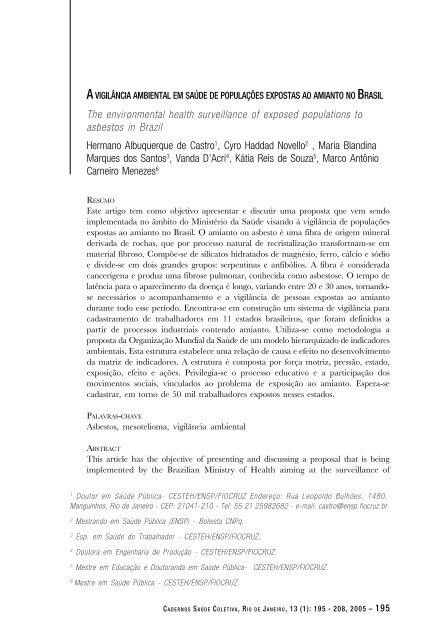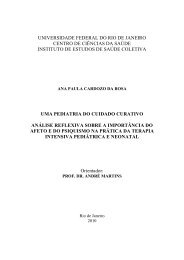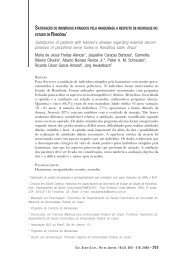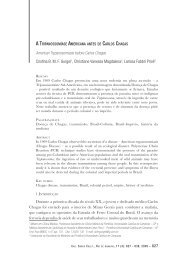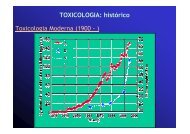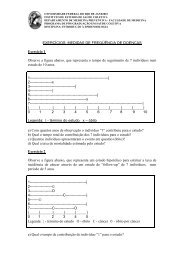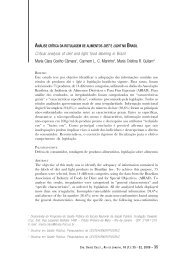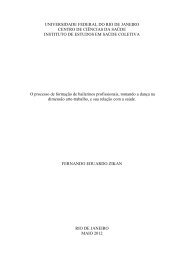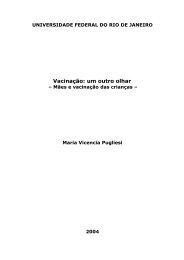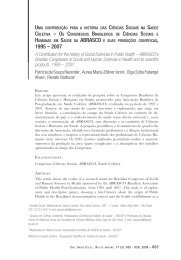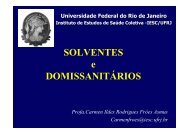A vigilância ambiental em saúde de populações expostas ao ...
A vigilância ambiental em saúde de populações expostas ao ...
A vigilância ambiental em saúde de populações expostas ao ...
You also want an ePaper? Increase the reach of your titles
YUMPU automatically turns print PDFs into web optimized ePapers that Google loves.
A VIGILÂNCIA AMBIENTAL EM SAÚDE DE POPULAÇÕES EXPOSTAS AO AMIANTO NO BRASIL<br />
The environmental health surveillance of exposed populations to<br />
asbestos in Brazil<br />
Hermano Albuquerque <strong>de</strong> Castro 1 , Cyro Haddad Novello 2 , Maria Blandina<br />
Marques dos Santos 3 , Vanda D’Acri 4 , Kátia Reis <strong>de</strong> Souza 5 , Marco Antônio<br />
Carneiro Menezes 6<br />
RESUMO<br />
Este artigo t<strong>em</strong> como objetivo apresentar e discutir uma proposta que v<strong>em</strong> sendo<br />
impl<strong>em</strong>entada no âmbito do Ministério da Saú<strong>de</strong> visando à <strong>vigilância</strong> <strong>de</strong> <strong>populações</strong><br />
<strong>expostas</strong> <strong>ao</strong> amianto no Brasil. O amianto ou asbesto é uma fibra <strong>de</strong> orig<strong>em</strong> mineral<br />
<strong>de</strong>rivada <strong>de</strong> rochas, que por processo natural <strong>de</strong> recristalização transformam-se <strong>em</strong><br />
material fibroso. Compõe-se <strong>de</strong> silicatos hidratados <strong>de</strong> magnésio, ferro, cálcio e sódio<br />
e divi<strong>de</strong>-se <strong>em</strong> dois gran<strong>de</strong>s grupos: serpentinas e anfibólios. A fibra é consi<strong>de</strong>rada<br />
cancerígena e produz uma fibrose pulmonar, conhecida como asbestose. O t<strong>em</strong>po <strong>de</strong><br />
latência para o aparecimento da doença é longo, variando entre 20 e 30 anos, tornandose<br />
necessários o acompanhamento e a <strong>vigilância</strong> <strong>de</strong> pessoas <strong>expostas</strong> <strong>ao</strong> amianto<br />
durante todo esse período. Encontra-se <strong>em</strong> construção um sist<strong>em</strong>a <strong>de</strong> <strong>vigilância</strong> para<br />
cadastramento <strong>de</strong> trabalhadores <strong>em</strong> 11 estados brasileiros, que foram <strong>de</strong>finidos a<br />
partir <strong>de</strong> processos industriais contendo amianto. Utiliza-se como metodologia a<br />
proposta da Organização Mundial da Saú<strong>de</strong> <strong>de</strong> um mo<strong>de</strong>lo hierarquizado <strong>de</strong> indicadores<br />
ambientais. Esta estrutura estabelece uma relação <strong>de</strong> causa e efeito no <strong>de</strong>senvolvimento<br />
da matriz <strong>de</strong> indicadores. A estrutura é composta por força motriz, pressão, estado,<br />
exposição, efeito e ações. Privilegia-se o processo educativo e a participação dos<br />
movimentos sociais, vinculados <strong>ao</strong> probl<strong>em</strong>a <strong>de</strong> exposição <strong>ao</strong> amianto. Espera-se<br />
cadastrar, <strong>em</strong> torno <strong>de</strong> 50 mil trabalhadores expostos nesses estados.<br />
PALAVRAS-CHAVE<br />
Asbestos, mesotelioma, <strong>vigilância</strong> <strong>ambiental</strong><br />
ABSTRACT<br />
This article has the objective of presenting and discussing a proposal that is being<br />
impl<strong>em</strong>ented by the Brazilian Ministry of Health aiming at the surveillance of<br />
1<br />
Doutor <strong>em</strong> Saú<strong>de</strong> Pública- CESTEH/ENSP/FIOCRUZ En<strong>de</strong>reço: Rua Leopoldo Bulhões, 1480,<br />
Manguinhos, Rio <strong>de</strong> Janeiro - CEP: 21041-210 - Tel: 55 21 25982682 - e-mail: castro@ensp.fiocruz.br<br />
2<br />
Mestrando <strong>em</strong> Saú<strong>de</strong> Pública (ENSP) - Bolsista CNPq.<br />
3<br />
Esp. <strong>em</strong> Saú<strong>de</strong> do Trabalhador - CESTEH/ENSP/FIOCRUZ.<br />
4<br />
Doutora <strong>em</strong> Engenharia <strong>de</strong> Produção - CESTEH/ENSP/FIOCRUZ.<br />
5<br />
Mestre <strong>em</strong> Educação e Doutoranda <strong>em</strong> Saú<strong>de</strong> Pública- CESTEH/ENSP/FIOCRUZ.<br />
6<br />
Mestre <strong>em</strong> Saú<strong>de</strong> Pública - CESTEH/ENSP/FIOCRUZ.<br />
C ADERNOS SAÚDE COLETIVA, RIO DE JANEIRO, 13 (1): 195 - 208, 2005 – 195
H ERMANO ALBUQUERQUE DE CASTRO, MARIA BLANDINA MARQUES DOS SANTOS,<br />
V ANDA D’ACRI, KÁTIA REIS DE SOUZA, MARCO ANTÔNIO CARNEIRO MENEZES, CYRO HADDAD NOVELLO<br />
populations exposed to asbestos in Brazil. Asbestos is a fiber of mineral origin that<br />
becomes fibrous material by a natural process of recrystallization. It is composed of<br />
hydrated magnesium silicates, iron, calcium and sodium, and it is separated in two<br />
great groups: serpentine and amphiboles. The fiber is consi<strong>de</strong>red cancerous and produces<br />
a type of lung fibrosis, known as asbestosis. The period of latency of the disease is long<br />
and may vary between 20 and 30 years, making it necessary the close surveillance of<br />
people exposed to asbestos during the referred period. A surveillance syst<strong>em</strong> for workers<br />
is being created in 11 States in Brazil, which were <strong>de</strong>fined as the starting point of<br />
industrial processes containing asbestos. The proposal of the World Health Organization<br />
is used as a methodology of a nested mo<strong>de</strong>l of environmental indicators. This structure<br />
establishes a cause and effect relationship in the <strong>de</strong>velopment of the indicators matrix.<br />
The structure is composed by Driving force, Pressure, State, Exposure, Effect and<br />
Actions. The educational process and the social mov<strong>em</strong>ent’s participation, linked to<br />
the probl<strong>em</strong> of asbestos exposure are privileged in this structure. It is expected the<br />
registration of around 50,000 exposed workers in those States.<br />
KEY WORDS<br />
Asbestos, mesothelioma, environmental surveillance<br />
196 – CADERNOS SAÚDE COLETIVA, RIO DE JANEIRO, 13 (1): 195 - 208, 2005


